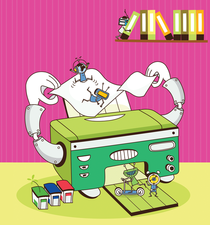Audex, the lean audio CD ripper
Rip, Rip, Hurray

With the Audex CD ripper, you can start digitizing your personal music collection immediately.
Linux has long established itself as a multimedia platform. The resulting wealth of applications makes it difficult to find the right program, especially for the casual user. If you want to rip audio CDs for your private party, your options at first glance are heavyweights like K3b, Rhythmbox, or Amarok, which all require significant familiarization time – or you can get started within 30 seconds with the compact audio ripper Audex [1] .
Installation
Audex is found in the software repositories of the major distributions; you can install it with a couple of mouse clicks using your distribution's graphical package manager. Depending on the distribution, you will then find an appropriate starter in the Multimedia or Entertainment submenu. The software quickly opens a self-explanatory program window in which – initially – no active controls appear, except for the menubar.
After you insert an audio CD, Audex reads its content and displays the titles in a list view on the right side of the application window (Figure 1). If you have an Internet connection, it automatically downloads the metadata, such as the cover, title, year, and genre, from the Freedb.org servers. If the ripper finds several CDs with the same title in the Freedb.org database, you can select the correct medium in the next dialog.
[...]
Buy this article as PDF
(incl. VAT)
Buy Linux Magazine
Subscribe to our Linux Newsletters
Find Linux and Open Source Jobs
Subscribe to our ADMIN Newsletters
Support Our Work
Linux Magazine content is made possible with support from readers like you. Please consider contributing when you’ve found an article to be beneficial.

News
-
KDE Unleashes Plasma 6.5
The Plasma 6.5 desktop environment is now available with new features, improvements, and the usual bug fixes.
-
Xubuntu Site Possibly Hacked
It appears that the Xubuntu site was hacked and briefly served up a malicious ZIP file from its download page.
-
LMDE 7 Now Available
Linux Mint Debian Edition, version 7, has been officially released and is based on upstream Debian.
-
Linux Kernel 6.16 Reaches EOL
Linux kernel 6.16 has reached its end of life, which means you'll need to upgrade to the next stable release, Linux kernel 6.17.
-
Amazon Ditches Android for a Linux-Based OS
Amazon has migrated from Android to the Linux-based Vega OS for its Fire TV.
-
Cairo Dock 3.6 Now Available for More Compositors
If you're a fan of third-party desktop docks, then the latest release of Cairo Dock with Wayland support is for you.
-
System76 Unleashes Pop!_OS 24.04 Beta
System76's first beta of Pop!_OS 24.04 is an impressive feat.
-
Linux Kernel 6.17 is Available
Linus Torvalds has announced that the latest kernel has been released with plenty of core improvements and even more hardware support.
-
Kali Linux 2025.3 Released with New Hacking Tools
If you're a Kali Linux fan, you'll be glad to know that the third release of this famous pen-testing distribution is now available with updates for key components.
-
Zorin OS 18 Beta Available for Testing
The latest release from the team behind Zorin OS is ready for public testing, and it includes plenty of improvements to make it more powerful, user-friendly, and productive.

